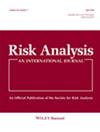英国进口日本食品中铯的定量风险评估
IF 3
3区 医学
Q1 MATHEMATICS, INTERDISCIPLINARY APPLICATIONS
引用次数: 0
摘要
2011 年,一座核电站的损坏导致日本某些地区受到放射性污染。欧洲制定了立法,对某些类型的食品和饲料的进口进行控制,包括每公斤每秒 100 个放射性衰变(贝克勒尔,Bq)的铯含量限制。英国在脱离欧盟后保留了这一立法,并在 2021 年进行了审查。英国制定了一项定量风险评估,以估算如果取消铯的最高含量,食用进口到英国的日本食品对公众健康造成的放射性风险。虽然日本的监测数据显示产品放射性活度浓度超过每千克 100 Bq 上限的情况时有发生,但这种情况非常罕见;在本次评估范围内的所有测量食品样本(100 万个)中,共有 1485 次(0.0013%)放射性活度浓度超过每千克 100 Bq。根据记录的发生率和测得的铯含量,以及目前从日本进口食品的模式和数量,估计每年致命癌症的超额风险约为百万分之一,与 2018-2020 年英国癌症死亡率约为四分之一的基线相比,可以忽略不计。根据上述评估和估计的微小额外风险,英国取消了与日本食品中的放射性有关的进口管制。针对本次评估中的数据缺口和方法提出了一些建议,特别是我们如何改进英国人对专业食品的饮食习惯建模。本文章由计算机程序翻译,如有差异,请以英文原文为准。
Quantitative risk assessment of radiocesium associated with Japanese foods imported into the United Kingdom
Damage to a nuclear power station resulted in radioactive contamination of certain areas of Japan in 2011. Legislation was put in place in Europe to establish controls on the import of certain types of food and feed, including a limit of 100 radioactive decays (becquerel, Bq) per second of radiocesium per kg. This legislation was retained in the United Kingdom after leaving the EU and then reviewed in 2021. A quantitative risk assessment was developed to estimate the radiological risk to public health from consuming Japanese food imported into the United Kingdom should the maximum level on radiocesium be removed. Although Japanese monitoring data indicated occurrences when products exceeded the 100 Bq per kg limit, these were found to be rare; a total of 1485 occurrences (0.0013%) of all measured foodstuff samples (>1 million) within the scope of this assessment had radiocesium activity concentrations that exceeded 100 Bq per kg. Using the recorded occurrence and level of radiocesium measured, and the current pattern and volume of food imported from Japan, there was an estimated excess risk of fatal cancer of around one in a million per year, categorized as negligible compared to the baseline 2018–2020 UK cancer fatality rate of around 1 in 4. On the basis of the described assessment and the estimated small additional risk, Great Britain lifted import controls related to radioactivity present in food from Japan. A number of recommendations to address data gaps and approaches in this assessment are made, particularly how we can improve modeling UK dietary habits for specialist foods.
求助全文
通过发布文献求助,成功后即可免费获取论文全文。
去求助
来源期刊

Risk Analysis
数学-数学跨学科应用
CiteScore
7.50
自引率
10.50%
发文量
183
审稿时长
4.2 months
期刊介绍:
Published on behalf of the Society for Risk Analysis, Risk Analysis is ranked among the top 10 journals in the ISI Journal Citation Reports under the social sciences, mathematical methods category, and provides a focal point for new developments in the field of risk analysis. This international peer-reviewed journal is committed to publishing critical empirical research and commentaries dealing with risk issues. The topics covered include:
• Human health and safety risks
• Microbial risks
• Engineering
• Mathematical modeling
• Risk characterization
• Risk communication
• Risk management and decision-making
• Risk perception, acceptability, and ethics
• Laws and regulatory policy
• Ecological risks.
 求助内容:
求助内容: 应助结果提醒方式:
应助结果提醒方式:


